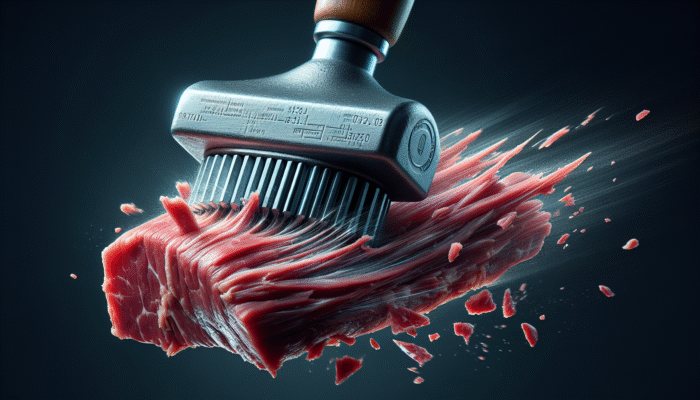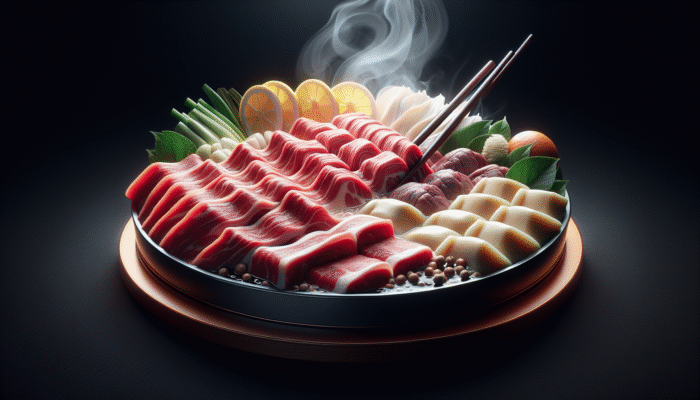Master the Art of Meat Tenderization: Transform Your Dishes with a Professional Meat Tenderizer
The remarkable functionality of a meat tenderizer lies in its distinctive ability to mechanically disrupt muscle fibers within various types of meat. This technique not only significantly enhances the tenderness of meats but also substantially enriches their overall flavor. By exploring the intricate interplay between texture, flavor, and diverse cooking methods, both amateur cooks and seasoned chefs can leverage these insights to create exquisite culinary masterpieces that tantalize the taste buds and elevate the overall dining experience.
Understanding How Meat Tenderization Works Mechanically

The mechanical action of a tenderizer effectively disrupts the tough muscle fibers found in various cuts of meat. This process is particularly essential for enhancing the tenderness of naturally tough cuts, such as brisket or chuck, which originate from muscles that have been heavily exercised, resulting in a fibrous and chewy texture. By breaking down these fibers, a tenderizer modifies the structural integrity of the meat, transforming it into a more enjoyable and succulent option, ultimately enriching the dining experience.
As the meat becomes increasingly tender, the overall eating experience undergoes a profound transformation. Diners find chewing to be significantly less laborious, allowing them to savor the rich flavors without the distraction of tough fibers. This improvement is crucial in various culinary settings, from traditional Australian barbecues to hearty European stews, where the balance of texture and flavor is vital for the enjoyment of any dish served.
Increasing Surface Area for Superior Marinade Absorption
The mechanical disruption of muscle fibers not only tenderizes the meat but also significantly amplifies its surface area. This expanded surface area permits marinades and spices to penetrate more deeply, enhancing the flavor profile of the dish significantly. As the meat becomes more porous and tender, the seasoning can effectively permeate every bite, ensuring that the flavors are infused throughout rather than merely coating the exterior.
Imagine the delightful sensation of biting into a perfectly marinated steak or chicken breast that erupts with flavor. This phenomenon is especially noticeable in various global cuisines that emphasize marinades, such as the citrus-infused marinades celebrated in Caribbean cuisine or the intricate spice blends found in Middle Eastern dishes. The tenderizer’s remarkable ability to enhance flavor through improved marinade absorption is undeniably transformative for both home cooks and culinary professionals alike.
Boosting Juiciness for a Memorable Culinary Experience
Juiciness is a hallmark of premium-quality meat that many diners yearn for, and the mechanical action of a meat tenderizer is crucial for retaining moisture within the meat. By creating a more tender structure, the meat is better suited to hold onto its natural juices throughout the cooking process, significantly enriching its flavor. This is essential for achieving that succulent experience that diners crave.
When cooked to perfection, a tender piece of meat preserves its juices instead of allowing them to escape into the cooking environment, resulting in an indulgent eating experience. This aspect is particularly vital in high-heat cooking techniques like grilling or roasting, where moisture loss can transform a dish into a dry final product. The juicy, flavorful meat that arises from the tenderization process is what culinary traditions strive for, whether in a classic barbecue setting or an elegant gourmet dish.
Delving into Enzymatic Action for Superior Meat Tenderization and Flavor Enhancement

In addition to mechanical factors, the enzymatic properties of a meat tenderizer play a pivotal role in enhancing flavor. These natural compounds function at a molecular level to decompose proteins, resulting in a notable improvement in the meat’s texture and taste. Understanding the intricacies of these enzymes can provide valuable insights for achieving optimal results in meat preparation and flavor enhancement.
Comprehending Protein Degradation for Ideal Tenderness and Flavor
Enzymes such as papain (derived from papaya) and bromelain (from pineapple) are frequently incorporated into meat tenderizers to facilitate the breakdown of proteins. These enzymes specifically target the long chains of amino acids that make up the proteins within meat, breaking them down into shorter, more manageable segments. This degradation process not only softens the meat but also significantly impacts flavor development.
As the proteins decompose, they release smaller peptides and amino acids, many of which contribute to umami, often considered the fifth flavor. The presence of umami is particularly important in meat, adding depth to flavors that are rich and satisfying. By utilizing enzyme-based tenderizers, culinary professionals can elevate the overall taste of their dishes, making them far more appealing to discerning diners.
Amplifying Flavor Enhancement Through Enzymatic Action
The enzymatic action involved in the tenderization process does more than simply soften the meat; it significantly enhances its flavor profile as well. As enzymes break down proteins, they can release pre-existing flavor compounds, intensifying the overall taste experience. This effect is particularly pronounced in tougher cuts of meat which, when prepared correctly, yield deep, complex flavors often absent in more tender cuts.
These intensified flavors can be savored across various cuisines. For instance, in South American barbecue cultures, where meats are marinated with tropical fruits rich in natural enzymes, the resulting dishes are vibrant and full of flavor, celebrating the art of grilling. This exemplifies how enzymatic tenderizers can transform ordinary dishes into extraordinary culinary experiences.
Refining Texture for an Unforgettable Dining Experience

Achieving the optimal texture is a fundamental aspect of cooking meat. The enzymatic processes not only tenderize but also yield a smoother, more enjoyable texture. Meat subjected to enzymatic tenderization is not only softer but also offers a satisfying mouthfeel, greatly enhancing the overall dining experience.
When cooked, tenderized meat maintains a desirable texture that keeps diners engaged with each bite. This quality becomes particularly important in cuisines that emphasize intricate flavors and textures, such as in Japanese cuisine, where the quality of the meat is crucial in dishes like shabu-shabu. The harmony between tenderness and texture significantly boosts the enjoyment of meat-based meals, making them memorable and delightful.
Increasing Nutritional Value Through Enzymatic Processes
Another noteworthy advantage of enzymatic tenderization is the potential increase in the bioavailability of essential amino acids. As proteins are broken down, the body can absorb these nutrients more effectively. For individuals focused on maximizing their protein intake, particularly athletes and health-conscious consumers, tenderizing meat can contribute positively to their dietary goals.
Moreover, the tenderization process can lead to a more pleasurable eating experience, encouraging individuals to increase their consumption of lean proteins as part of a balanced diet. This consideration is especially relevant in various global contexts where protein intake is a dietary focal point, from the protein-rich diets of the Mediterranean to the high-protein staples prevalent throughout the Americas.
Reducing Cooking Time for Enhanced Efficiency
The application of enzymes can significantly shorten cooking times, enhancing meal preparation efficiency. As the proteins break down, the meat becomes less dense, allowing heat to penetrate more swiftly during the cooking process. This time-saving aspect is invaluable for both busy home cooks and professional chefs alike.
Shorter cooking times not only save valuable time but also reduce energy consumption, which is beneficial for both the environment and your finances. In regions with high energy costs, such as parts of Europe or Australia, utilizing meat tenderizers can lead to substantial savings in cooking time and energy expenditure while still preserving flavor and quality.
Utilizing Marinade Absorption to Elevate Flavor with a Meat Tenderizer
The relationship between marinade and meat is a fundamental element of flavor enhancement that merits attention. When meat is tenderized, its capacity to absorb marinades increases significantly, directly influencing the overall flavor profile. Understanding this dynamic is essential for maximizing the taste potential of any dish.
Facilitating Improved Marinade Penetration
The structural alterations in meat caused by tenderization substantially enhance its ability to absorb marinades. A tenderizer creates channels within the meat that allow marinades to penetrate more effectively. This results in flavors enveloping the meat rather than merely coating the exterior, leading to a more cohesive taste experience.
When applying marinades rich in herbs, spices, and acids to tenderized meat, their effectiveness is amplified. Techniques like marinating overnight enable the meat to soak up the full spectrum of flavors, whether it’s the zesty brightness of citrus in a Thai marinade or the deep, smoky notes characteristic of a barbecue rub.
Achieving Deep Flavor Infusion for Complex Tastes
The deeper flavor infusion gained through tenderizing is crucial in crafting complex, layered tastes that resonate throughout the entire dish. When marinades penetrate thoroughly into the meat, they interact with the proteins and fats, creating flavor compounds that enrich each bite.
This is particularly significant in dishes that emphasize bold flavors, such as Mexican carne asada or Indian tikka, where the marinade’s spices and herbs meld beautifully with the meat. The infusion process transforms the meat from a simple protein source into a culinary canvas, showcasing the depth and richness of global flavors that excite the palate.
Ensuring Moisture Retention for Juicy Meat
One of the most significant advantages of marinating tenderized meat is its ability to retain moisture. When meat is marinated, it absorbs not only flavors but also moisture. This dual absorption ensures that the meat stays juicy during cooking, leading to a more gratifying eating experience.
Dishes such as Moroccan tagines, which depend on juicy, tender meat, exemplify the importance of moisture retention. In this context, the processes of tenderization and marination work in synergy to produce meat that melts in the mouth, bursting with flavor and moisture. The final outcome is a dish that feels luxurious and indulgent without being overly rich or heavy.
Improving Texture Through Tenderizing and Marinating
The combination of tenderizing and marinating can significantly enhance the meat’s texture. A tenderizer breaks down the fibers, enabling the marinade to work its magic, resulting in a meat product that is both tender and enjoyable to consume.
From perfectly grilled steak to juicy chicken thighs, the improved texture achieved through this process renders meals more pleasurable. The contrast between tender meat and the crispy exterior often found in grilled or roasted dishes creates a delightful eating experience celebrated across various cuisines.
Enhancing Cooking Efficiency with a Meat Tenderizer
Cooking efficiency is a vital consideration for anyone involved in meal preparation, whether at home or in a professional kitchen. Utilizing a meat tenderizer can significantly enhance this aspect, resulting in a streamlined cooking process that preserves quality and flavor.
Achieving Shorter Cooking Times for Greater Convenience
One of the most immediate benefits of using a meat tenderizer is the reduction in cooking time. Tenderized meat cooks faster due to its modified structure, allowing heat to penetrate more easily and resulting in a quicker cooking process. This efficiency is especially advantageous for busy individuals or those preparing large meals.
Consider the impact during family barbecues or dinner gatherings; tenderized meats facilitate faster preparation, allowing you to spend more time enjoying your guests’ company rather than laboring in the kitchen. This benefit is universally appreciated, whether in bustling urban settings or relaxed rural environments around the world.
Guaranteeing Even Cooking for Consistent Results
Another significant advantage of tenderized meat is the assurance of even cooking. When the fibers are broken down, the meat cooks more uniformly, reducing the risk of overcooked exteriors and undercooked interiors. This feature is critical for achieving the perfect medium-rare steak or ensuring chicken is thoroughly cooked without becoming dry.
The implications for both food safety and quality are considerable. With evenly cooked meat, diners can relish a consistent texture and flavor, which is particularly crucial across various culinary traditions, from Asian stir-fries to Western roasts.
Realizing Energy Savings for Sustainable Cooking Practices
Efficiency in cooking not only saves time; it also results in energy savings. With reduced cooking times, overall energy consumption decreases, making meal preparation more sustainable. This is an important consideration in our increasingly eco-conscious world, where minimizing energy usage is essential.
Cooks, whether at home or in restaurants, are increasingly recognizing the advantages of energy-efficient cooking methods, and tenderizing meat can significantly contribute to this goal. By adopting techniques that optimize cooking efficiency, chefs and home cooks can create delicious meals while being mindful of their environmental footprint and energy consumption.
Maximizing Versatility in Cooking Techniques with a Meat Tenderizer
The versatility that a meat tenderizer offers is a true game-changer for anyone passionate about cooking. Tenderized meat can be prepared using a wide array of cooking methods, each contributing uniquely to the overall flavor and experience of the dish.
Grilling for Flavorful Outcomes
Grilling is synonymous with flavor, and tenderized meat excels in this cooking method. The high heat of the grill can be unforgiving, but tenderized meat retains its juiciness and flavor, even when exposed to intense temperatures.
When grilling, the caramelization of sugars and the Maillard reaction enhance the meat’s natural flavors, resulting in a delectable crust. Tenderized cuts, be it steak or chicken breast, are ideal for this technique, ensuring that the final product is not only tender but also bursting with flavor, making it a popular choice at barbecues worldwide.
Roasting for Exquisite Results
Roasting is another cooking method where the benefits of using a meat tenderizer shine. Tenderized meat guarantees even cooking, which is crucial for larger cuts. The combination of dry heat and the breakdown of fibers results in a succulent, flavorful dish that is sure to impress.
Consider classic recipes like herb-crusted roast lamb. The tenderness achieved through tenderization allows for the full expression of spices and herbs, resulting in a dish that resonates with flavor. The ability to infuse and retain moisture ensures that the final product is not only enjoyable but also memorable, providing a culinary experience that diners will cherish.
Braising for Rich and Flavorful Outcomes
In braising, where meat is slowly cooked in liquid, tenderized pieces excel due to their enhanced tenderness. The slow cooking process allows the flavors of the braising liquid to permeate the meat, resulting in a rich, complex dish.
This technique is widely employed in cuisines that thrive on hearty meals, such as French coq au vin or Italian osso buco. The tenderization process ensures that the meat withstands long cooking times without becoming tough, leading to a delicious outcome that is both comforting and flavorful, embodying the essence of home cooking.
Crafting Elevated Flavor Profiles with a Meat Tenderizer
Enhancing flavor profiles is one of the most exciting aspects of utilizing a meat tenderizer. By improving the meat’s interaction with spices, herbs, and sauces, cooks can achieve a depth of flavor that elevates any dish to new heights of culinary excellence.
Integrating Spices for Maximum Flavor Penetration
Tenderized meat allows spices to meld more thoroughly, enhancing the overall flavor profile. The increased surface area and improved texture enable deeper penetration of spices, ensuring an even distribution of flavors throughout the meat.
In cuisines where spices are paramount, such as Indian or Middle Eastern cooking, the ability to fully integrate these flavors is essential. Dishes like biryani or shawarma rely on the complete immersion of spices into the meat, which cannot be achieved with tougher cuts. The tenderizing process ensures that every bite is bursting with flavor, resonating with the rich culinary traditions of these cultures.
Infusing Herbs for Elevated Flavor Profiles
Herbs, often used to brighten and elevate dishes, benefit significantly from the tenderizing process. When herbs are applied to tenderized meat, they can penetrate deeply, imparting complex and aromatic flavors that linger on the palate.
Consider iconic dishes like Italian osso buco, where fresh herbs harmoniously combine with tenderized meat to create a symphony of flavors. The infusion of herbs not only enhances taste but also contributes to the visual allure of the dish, crafting a feast for the senses that embodies the essence of culinary artistry.
Enhancing Sauce Compatibility for Memorable Dishes
The compatibility of tenderized meat with various sauces cannot be overstated. The improved texture and flavor absorption capabilities ensure that sauces adhere well and amplify the overall dish. Whether it’s a rich barbecue sauce or a delicate chimichurri, tenderized meat offers the perfect canvas for culinary creativity.
In many global cuisines, sauces define the character of a dish—consider tangy salsa in Mexican cuisine or robust gravy in traditional British meals. The ability of tenderized meat to pair seamlessly with a variety of sauces enhances the overall taste experience, making each meal unforgettable and satisfying, leaving diners eager for more.
Creating a Superior Eating Experience with a Meat Tenderizer
Ultimately, the primary goal of cooking is to craft an enjoyable eating experience. The use of a meat tenderizer significantly enhances this experience by improving tenderness, flavor intensity, and texture variety. Understanding these elements can transform the way meals are appreciated and enjoyed.
Enhancing Tenderness for Effortless Consumption
Tenderized meat profoundly alters how diners engage with their food. Enhanced tenderness makes the meat easier to chew and savor, allowing the full spectrum of flavors to emerge without requiring excessive effort. This transformation is particularly critical in settings where the emphasis is on shared meals or communal dining experiences.
In cultures that celebrate food as a communal experience—think of a traditional Italian family meal or a South African braai—the ease of consuming tender meat fosters a convivial atmosphere. Diners can focus on conversation and enjoyment rather than grappling with tough fibers, greatly enriching the overall dining experience.
Maximizing Flavor Intensity for Lasting Impressions
The enhanced flavor intensity resulting from using a meat tenderizer is transformative. Each bite becomes a revelation, as tenderized meat bursts with flavor due to the processes of tenderization, marination, and cooking. This transformation resonates powerfully with diners, creating a memorable meal that lingers long after the last bite.
For chefs and home cooks alike, this intensity serves as a point of pride, enabling them to showcase their culinary skills and creativity. Dishes rich in flavor resonate deeply with diners, often leading to repeat requests and cherished memories of shared meals, solidifying the tenderizer’s role in creating unforgettable dining experiences.
Enhancing Texture Variety for a Delightful Dining Experience
Texture variety is a crucial aspect of the dining experience, and tenderization allows for a range of textures that enhance enjoyment. The contrast between tender meat and accompanying elements like crisp vegetables or creamy sauces creates a multi-layered experience that engages the palate in exciting ways.
In various culinary traditions, the appreciation for texture is paramount. Consider the balance of textures in Japanese kaiseki dining or the interplay of tender meat with crunchy pickles in Korean barbecue. The ability to create and appreciate this variety is significantly enhanced when meat is tenderized, leading to a satisfying and delightful meal that leaves diners craving more.
Addressing Common Questions About Meat Tenderizers
What is a meat tenderizer, and how does it work?
A meat tenderizer is a tool or substance designed to break down tough muscle fibers in meat, making it softer and easier to chew, ultimately enhancing the overall eating experience.
In what ways does a meat tenderizer improve flavor?
A meat tenderizer enhances flavor by breaking down muscle fibers, allowing marinades and spices to penetrate deeply, resulting in more intense and evenly distributed flavors.
Can I utilize natural tenderizers?
Absolutely! Natural tenderizers such as pineapple, papaya, or vinegar are highly effective. They contain enzymes that aid in breaking down proteins, making the meat tender and flavorful.
Are meat tenderizers safe to use?
Yes, meat tenderizers are generally considered safe when used as directed. However, it’s essential to follow the recommended usage instructions to prevent over-tenderizing the meat, which can negatively impact its texture and quality.
What is the ideal duration for tenderizing meat?
The time required to tenderize meat varies based on the type and thickness of the cut. Typically, 30 minutes to a few hours is sufficient, but over-tenderizing can lead to excessively mushy meat, which is not desirable.
Which cuts of meat gain the most from tenderization?
Tougher cuts of meat, such as flank steak, brisket, and chuck roast, benefit the most from tenderizing, as they contain more connective tissue that can be effectively broken down.
Can tenderized meat be cooked using any method?
Yes, tenderized meat can be grilled, roasted, braised, or sautéed, and it often cooks more evenly and quickly compared to un-tenderized cuts, making it versatile for various cooking techniques.
Does tenderizing affect the nutritional value of meat?
Tenderizing meat can enhance the bioavailability of essential amino acids, allowing the body to absorb these nutrients more efficiently, thus positively contributing to dietary objectives.
How can I determine if meat has been tenderized properly?
Properly tenderized meat should feel soft to the touch and display a more uniform texture. It should be easy to cut and chew when cooked, indicating successful tenderization.
Is it possible to tenderize meat at home?
Yes, you can easily tenderize meat at home using tools like mallets, forks, or natural tenderizers like fruit juices, making it accessible for everyday cooking.
Connect with us on Facebook!
The post Why a Meat Tenderizer Improves Flavor: Enhancing Taste and Texture appeared first on https://cookinggods.com
The Article Meat Tenderizer Enhances Flavor and Texture for Better Meals Was Found On https://limitsofstrategy.com
